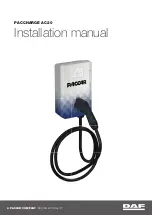
15 POWER FLOW DIFFERENTIAL (Hewland)
This differential is designed with versatility as its major asset. Many parameters will lead you to the
required setting. A car with good grip and limited power requires a very different arrangement than
that required for a high poor grip/high power car.
Working principles: Ten friction plates within the diff, six connected to the side gears, four to the diff
casing, control the amount of ‘differential’ action. The amount of
limited slip only depends on the friction force
between these ten plates.
Four factors contribute to the level of this friction force:
1.
The bevel gears thrust apart as soon as the car moves. This is a feature of bevel gears and is not
adjustable. The contribution of this on friction is minimal.
2.
The ramp angle on the side gear ring influences the amount of the driving force on the diff that gets
directed sideways and onto the plates. E.g. on the power/drive side ramp, 60 degrees transmits less force
sideways than a 30 degree ramp. Likewise, on the off-power side ramp, an 80 degrees angle will transmit
little force while 45 degrees locks more. 60°/80° is fitted as standard;
3.
The pre-load with which they are assembled to start. In each diff there is a pre-load spacer that looks like
one of the B plates, but thicker. Depending on diff model, it is either the first or the last component
assembled into the diff casing. Its thickness dictates to what degree the plates are pre-loaded / forced
against each other. The pre-load is set and checked on each diff by holding one side gear locked, via a
dummy output shaft locked in a vice, and by turning the other with a torque wrench. If the measured
resistance is deemed too high, the spacer is ground down until the desired figure is achieved. The preload
should be checked periodically as it tends to reduce as the diff runs, meanwhile a slightly thicker spacer will
allow re-setting;
4.
The re-arrangement of the order of the friction discs. The arrangement 1, with a disc succession A, B, A, B,
A, has the maximum number of working friction faces. It gives the maximum resisting torque. The
arrangement 3 has the minimum of working friction faces and gives the minimum resisting torque.
Standard Hewland available ramp angles are: 30/60; 45/45; 45/80; 60/80; 80/80; optional: ramps including 70
Differential settings have an important influence on the car’s balance throughout the corner. Also handling is
affected, especially so on corner turn-in and exit.
¾
The torque on the differential in drive (acceleration) is much bigger than the torque on the differential
given by the engine brake (deceleration). Typical in line acceleration gets to about 1g starting from a
relatively low speed, off-power/braking by the engine only gets typically up to 0.3g.
¾
The disc configuration (2, 4 or 6 faces) has the same effect on drive and off-power, the ramps are the
only tool to differentiate the friction force or ‘lock’ between drive and brake.
¾
The discs wear off, just as a clutch, and should get checked regularly. This also means that the pre-
load is ‘wearing’ down, faster so when using the 2 friction discs configuration and significantly less
when using 6 friction faces.
¾
Pre-load is kind of a ‘constant lock’ and the effect is felt in slow and fast corners in entry, mid-corner
and exit. The ramps and disc configurations typically have more effect in slow and less in fast corners,
and affect corner entry and exit, less so mid-corner.
¾
Pre-load locks the differential (both wheels turn at the same speed) until the difference in torque is
higher than the pre-load. Once passed the pre-load, the remaining lock is achieved by the ramps and
disc configuration mainly.
¾
Most circuits require little lock to prevent the inner wheel from spinning coming out of corners,
depending though on tyres, track, driving style and weather conditions. Excessive lock might result in
power understeer.
¾
Some amount of lock in off-power helps to stabilize the rear end, excessive lock might cause turn-in
understeer.
This table shows the % of lock from minimum to maximum lock.
Lock%= (slower wheel torque – faster wheel torque)/ total torque
LOCK% 2.5 5.0 7.0 9.5 11 12.0 15.5 18.0 24.0 25.0 33.5 42.0 44.0 55.0 68.5
RAMP
80
80
70
80
70
60
70
60
45
60
45
30
45
30
30
DISCS
2
4
2
6
4
2
6
4
2
6
4
2
6
4
6
















































